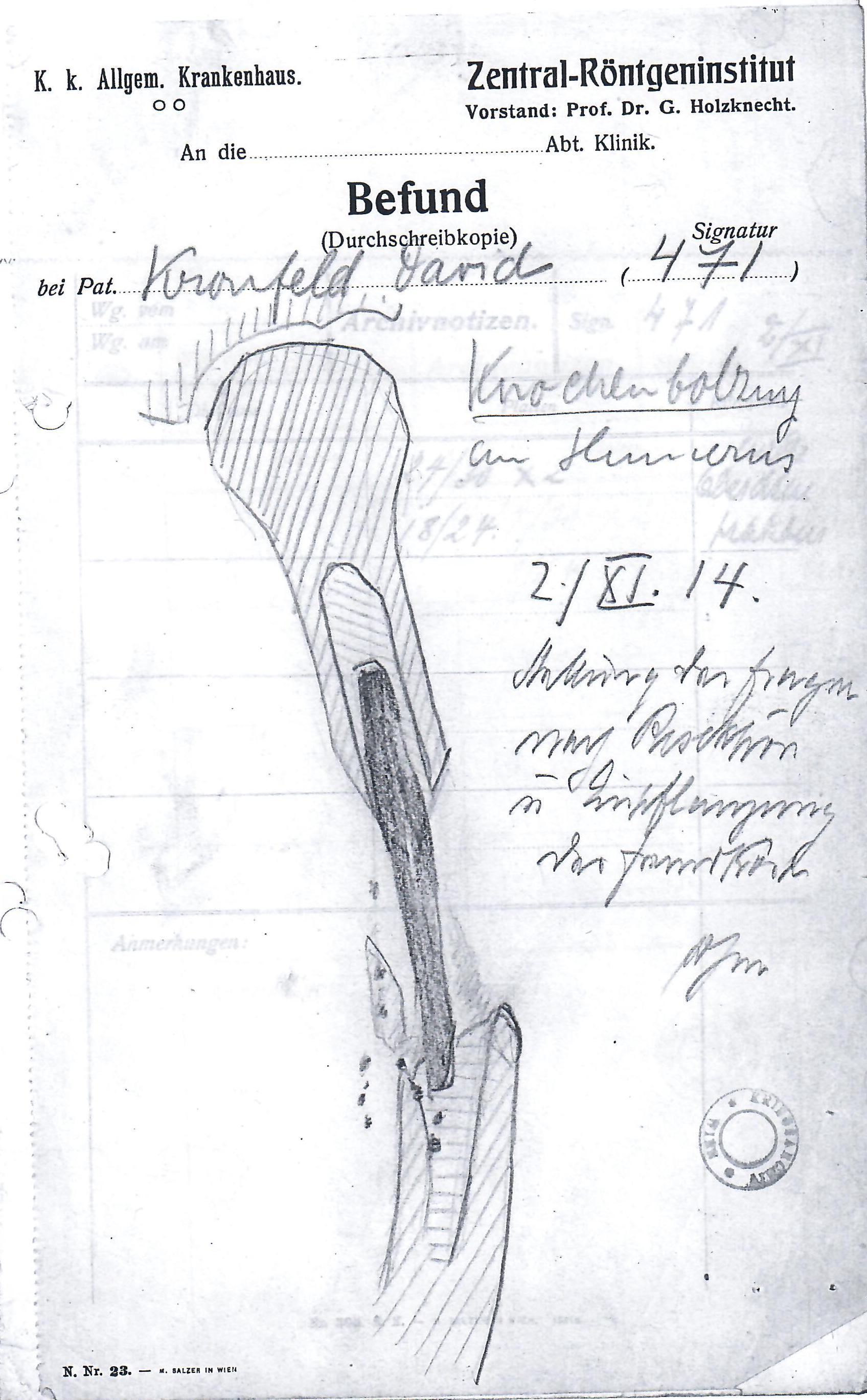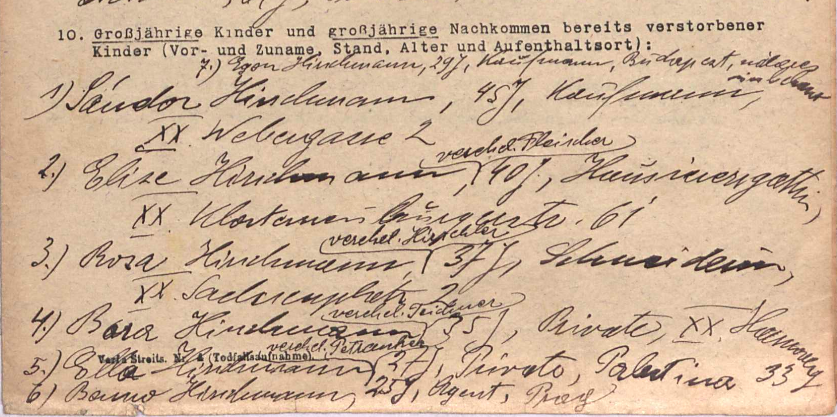My ancestor David Kronfeld was born in modern-day Łańcut, Poland in December of 1874. David and his family considered themselves Polish. All of his children went to secular school in Lwów (modern-day Lviv, Ukraine), with students of mixed religion, and they spoke in Polish. At the time of his birth, though, the places where David lived were not "Polish" per se; they were located in the province of Galicia, within the Austrian Empire. And like many other young men at the far edges of the Austrian Empire, David was drafted into the Austrian Army.
There is only one known large collection that survives of Austrian Empire soldiers from this time period that cover those living in the territory of Galicia, which are available through FamilySearch here. But they are not indexed and there are thousands and thousands of pages (although separated by letter, they are not in any easily managed order to find an individual's file).
The only documentary evidence that I had that David was actually drafted into the Austrian army was a reference on his marriage certificate from Lwów, which stated in a notation that David had presented a military passport that was issued in Rzeszów (not far from Łańcut). However, when I contacted the archives in both Lviv and Rzeszów, they both said that they had no documents of relevance that could help.
Our family did retain one other item of relevance: an amazing portrait that was made of David at some time in his later years, showing him in military uniform.
 |
| Portrait of David Kronfeld in military uniform |
David Appears in an Unlikely Place
I have a lot of ancestors that lived in both the Austrian and Hungarian sides of the former Austro-Hungarian Empire, so I monitor large collections that are available from these regions. One ever-growing database is a list of Austrian Empire casualties from World War I. These records not only include those who died in combat, but also casualties and prisoners of war. One of the places these casualty lists can be searched is on the
GenTeam website, which has many databases relating to Vienna and Austria in general (as well as some other places), as well as
MyHeritage and a Hungarian database called
RadixIndex. All of them have different amounts of the records indexed, so it is worthwhile checking different lists.
What all of these databases don't have, though, is the ability to search for yourself in the un-indexed records. This ability we luckily get elsewhere - in the Austrian National Library's historical newspaper database, available
here. This database is incredibly valuable and lets you search (with very easy search functions) through more than 1,400 different newspaper titles, totaling over 24 million pages of searchable data.
[
See here for another post of mine highlighting the incredible value of newspaper databases!]
Because the historical region of Galicia was part of the Austrian Empire, I often search for information on individuals from this region to see if they appeared in the Austrian newspapers (which also include Polish language newspapers from some places that are in modern-day Poland, like Lviv). Sometimes, you really never know what you can find (for example, a listing of my ancestor living in Romania whose ancestors came from Galicia who had to register with the Austrian consulate in 1863 that he had filed for bankruptcy...!).
Well, I searched this database one time for my ancestor David Kronfeld and got a surprising result: he appeared (at age 39) in a World War I casualty list.
 |
| David Kronfeld appears in an Austrian World War I casualty list |
The entry, dated October 14, 1914, was very intriguing. It said David was in an infantry regiment from Lemberg (which is the German name for Lwów/Lviv) and that he was born in 1874. After doing research, I concluded there was no other person that fit so precisely; this had to be my ancestor. But the rest of the entry contained a surprise: David was shot in the left forearm, and he was in a hospital in Vienna. Then I found another entry for David from a casualty list from November 5, 1914, now saying that he was in a hospital recovering in Krakow.
Next, I spent a lot of time searching World War I narratives to try to understand where my ancestor fought in battle that he could have been shot in the forearm. I followed paths of his regiment, but it was a little confusing, as Archduke Franz Ferdinand had only been killed four months earlier... the war had barely begun. What actually happened to David?
I contacted a variety of military archives to try to understand what happened to David, but I had no luck. Then I tried something else: I thought, maybe the Austrian Archives retains records relating to this since David ended up in Vienna. Since Viennese records are far more preserved than those from Galicia, maybe that would yield some success. I wrote a very simple email to the Austrian Archives:
I have found 2 entries for the same individual in the listings Nachrichten über Verwundete und Verletzte, and I am seeking whatever information has survived (hospital records? muster lists? etc.). Since it appears David Kronfeld was in a hospital in Vienna, I suspect records may have survived in Vienna.
20 Oct 1914: Kronfeld, David, Inft., k.k. LstIR Nr. 19, 2. Komp., Lemberg, 1874, Schuss i. d. l. Oberarm, VereinsResSpit. Nr. 1 in Wien, XVI
05 Nov 1914: Kronfeld, David, Inft., k.k. LstIR No. 19, 2. Komp., Lemberg, 1874, Schuss i. d. l. Oberarm, Festungsspital Nr. 3 in Krakau
Please let me know what might be available about this individual.
I eventually received a reply that the Austrian War Archives did retain casualty records for those in Vienna and that they could perform some research for a small fee. Two weeks later, I received in the mail a large envelope filled with a few dozen pages. I was surely not expecting what was inside: hospital records!
Indeed, the Austrian War Archives sent me pages and pages of handwritten notes and drawings regarding David's injury, and most interestingly, what the x-ray imaging showed of his arm (based on hand drawings), and how his arm was healing. Fascinating! There were also plenty of handwritten notes, on a day-by-day basis, which identified that David was shot in the forearm and how he was healing, but nothing unfortunately identified what had happened to him. The 108-year-old documents of my ancestor's injury and treatment are truly remarkable.
So What Actually Happened to David?
What the records do not tell, though, is how did David get shot in the arm? The answer lies in family lore that I only learned afterwards. When I discovered this fascinating story, I relayed it to my father (David's great-grandson). And as sometimes occurs in the genealogical world, this story sparked a memory in my dad's head that he hadn't thought of in nearly 50 years. Immediately, my dad recalled a story that he had been told from
his grandfather, David's son:
David shot himself in the arm. David was about to turn 40 years old, the region of Galicia where David lived was becoming increasingly Polish-nationalist, and David was married with four children, with his wife pregnant with their fifth child. With four young children and a wife pregnant with another, David’s actions are seemingly understandable to escape what would have been atrociously brutal military service (or death), although purely crazy to imagine shooting yourself in the arm. Luckily, though, David survived and seems to have recovered.
While David was in the military hospital recovering, it appears his wife and family came all the way to Vienna to visit him, although the details are a bit confusing. On October 13, 1914, David submitted a notice in the Viennese newspaper Neues Wiener Abendblatt seeking information about his wife Rachel and four children with a Frau Malwine Molnar in Vienna; why he needed to submit a newspaper article about this is unclear.
 |
| David Kronfeld inquires about his family in the Neues Wiener Abendblatt newspaper, October 13, 1914 |
The date of this article places Rachel into her ninth month of pregnancy. It is thus possible that, in addition to potentially visiting her husband, Rachel and her children may have traveled to Vienna in order for Rachel to have her child. However, the child that was born always stated that he was in fact born in Lwów (unfortunately, the birth records from November 1914 don't appear to have survived from there). So it appears that Rachel and children must have actually returned to Lwów in the meantime to have her child, who was born on November 6, 1914. Meanwhile, it appears David was then in the military hospital in Krakow. Amazingly, all worked out. David eventually returned to Lwów, where the family continued to live for many more years, before leaving Europe for good.
 |
| Colorized image of David and Rachel Kronfeld with two of their grandchildren, ca. 1935, British Mandate of Palestine |
Enjoyed this post? Sign up here to receive email updates for when new posts are available.









There is an index book of births from Lwów for the years 1914-1916.
ReplyDeletePrzemyśl State Archive 154/30/16.
good luck,
Daniella Alyagon